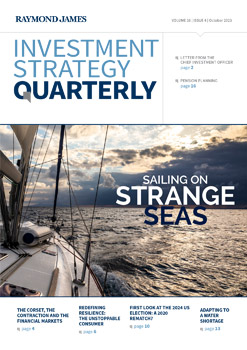This week we transitioned from October to November, leaving behind a very difficult month in markets, with the first few days of November proving very strong for equity and bond investors. We are just two days away from Guy Fawkes night, the conspirator who attempted to blow up the Houses of Parliament in 1605. November has certainly started with a bang as we have had multiple data releases and events causing fireworks in markets.
Arguably the most anticipated news of the week was the US Federal Reserve meeting on Wednesday. The base rate of 5.5% is a 22-year high and this went unchanged as the Fed opted to pause once more, following on from the previous meeting where rates were held steady. Market expectation was that the Fed would continue the pause to further see the impact higher rates were having on the economy. We have seen the US economy stand resilient despite the steepest rate rises in four decades, just last week we reported US GDP at 4.9% in the third quarter. Fed Chair, Jerome Powell was hawkish with his commentary as he stands firm on achieving the target inflation rate of 2%, however markets are convinced we have now seen the peak in rates, estimating only a small chance of an increase in the December meeting.
The Bank of England met on Thursday and followed suit as they also held rates steady at 5.25%. There was a change in the voting dynamic as Sarah Breeden succeeded Sir Jon Cunliffe on the monetary policy committee (MPC), and she was one of six to vote for rates to remain unchanged. Inflation played a vital role in the decision as it fell steeply in the month of July before staying sticky in the following months. It is estimated that inflation will drop further to 4.25% by the end of 2023. UK GDP projections for Q4 have weakened to 0.1% so the MPC must consider if this is now the peak in rates, as they do not want to overtighten policy, which could tip the UK into recession. There has been a huge change in UK rate expectations over the last 6 months, with the market believing in July that interest rates would be close to 7% by Q1 2024, which has now slipped to 5.25%.
Inflation in Germany has fallen to 3.8% in October (year-on-year), down from 4.5% in September. This is positive for the Euro zone as rates across Europe fall towards the 2% target, with the European Central Bank making it three out of three central banks to pause rates. The German economy however is still being weighed down as GDP fell by -0.1% for Q3. It has only grown twice over the last six quarters. There are concerns that the current geopolitical uncertainty will add further pressure to the economy as Germany still suffers from elevated energy prices since the war in Ukraine started.
Take a moment to guess what the Netherlands inflation rate for October was. Just two months ago it was 3% and preliminary results for the month of October came in at -0.4% (year-on-year). We can attribute this steep fall to the change in energy prices as gas and electricity peaked in October 2022. However, with a major European economy falling into deflation, it is a reminder how quickly outlooks can change.
The US Fed will have felt vindicated in their decision to pause, with US Non-Farm Payrolls data coming in weaker than expected on Friday. 150,000 jobs were added to the economy, against an expectation of 180,000. The slowdown in hiring is an indication that interest rates are continuing to bite, and the US economy is likely slowing as a result.
It has been a very strong week in markets, with confirmation of central banks holding rates steady, coupled with a weakening in data, leading investors to believe that the headwind of rising interest rates may now be behind us. By the close of play yesterday the UK mid-cap equity index had risen 5.8% during the week, and at the time of writing is up another 1% today. The US S&P 500 index was up around 4.5% and again has nudged higher today. These weekly returns from equity markets are similar to the one year returns available on cash at the moment; it’s a reminder about the dangers of attempting to time markets. It wasn’t just equities that performed well, with bond yields falling (therefore prices rising). We wrote about the US 10-year Treasury yield reaching 5% last week; that has now fallen to 4.5%, providing significant capital uplift this week.
Nathan Amaning, Investment Analyst
Risk warning: With investing, your capital is at risk. The value of investments and the income from them can go down as well as up and you may not recover the amount of your initial investment. Certain investments carry a higher degree of risk than others and are, therefore, unsuitable for some investors.







